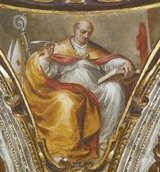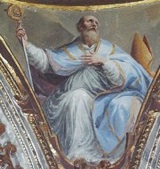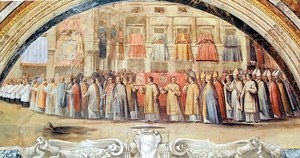

In his “Vite de’ Santi e Beati dell’ Umbria” (1647-61), Ludovico Jacobili writes that the Blessed Ludolf Pamphili founded the Eremo di Fonte Avellana in ca. 1000. No documentary evidence for this early history survives, and the existence of this putative founder is in doubt. (The hermitage was first documented in 1003, when Pope Sylvester II took it under papal protection).
The hermitage became renowned after St Peter Damian (see below) joined the community in 1034 and became its prior from ca. 1043. Three other venerated members of the community from this period are described in the page on saints claimed by the Gabrielli family:
-
✴St Forte Gabrielli (died 1040); and
-
✴St Rudolf Gabrielli (died in ca. 1064); and
-
✴the Blessed Peter Gabrielli (died after 1059).
The other figures described on this page are:
-
✴St John of Lodi (died 1105); and
-
✴St Albert of Montone (died 1294).
St Peter Damian (23rd February)

Fresco (1654-8) of St Peter Damian by Francesco Allegrini
Cappella del SS Sacramento, Duomo
An entry in the Roman Martyrology under 23rd February reads: “St Peter Damian, a Camaldolese monk, cardinal bishop of Ostia, confessor and doctor of the Church, who died on the 22nd of February”.
St Peter Damian was was born in ca. 1007 in Ravenna. He was orphaned at a young age and raised by two of his brothers. He added the name Damian to his own in memory of one of them, who had treated him with particular kindness. As noted above, he joined Fonte Avellanain 1035 after a chance encounter with two of its hermits. He was its prior from ca. 1043 until his death in 1072.
As prior of Fonte Avellana from 1043, he modified the severity of the rule and founded a number of dependent hermitages in what became known as the Order of Santa Croce di Fonte Avellana. According to one of his letters, he spent a period of time (probably in ca. 1050) governing and reforming the Abbazia di San Salvatore di Monte Acuto.
He was a noted Latin writer, and his works include the life of St Romuald, which he wrote in ca. 1042. He was also a strong advocate of church reform, and wrote the controversial Liber Gomorrhianus (Book of Gomorrah) on the vices of the clergy in ca. 1050. His sermon on the miracles attending the translation of the sarcophagus of St Rufinus is an important source for the early cult of this patron saint of Assisi.
In 1057, Pope Stephen IX made him as Cardinal Bishop of Ostia and administrator of the diocese of Gubbio against his will. Pope Nicholas II sent him as legate to Milan in 1059 to deal with problems of simony and clerical concubinage there. (This was probably the occasion of his first meeting with St John of Lodi (below). In 1069, Pope Alexander II sent him as legate to Germany to prevent the Emperor Henry IV from wrongly divorcing his wife. After repeated requests, Alexander II allowed him to retire soon after but, even in retirement, he travelled extensively on papal business. He died in ca. 1072 at Faenza, on his way back to Gubbio from Ravenna, where he had acted as papal legate. The authorities of Faenza refused to release his relics, and they remain in a chapel dedicated to him in the Duomo there.
St John of Lodi wrote an account of his life and produced a collection of his biblical commentaries. No formal canonisation ever took place, but in 1823 Pope Leo XII extended his feast to the whole Church and pronounced him a Doctor of the Church.
St John of Lodi (7th September)

Fresco (1654-8) of St John of Lodi by Francesco Allegrini
Cappella del SS Sacramento, Duomo
St John of Lodi probably met St Peter Damian when the latter was in Milan in 1059 on a diplomatic mission for Pope Nicholas II dealing with problems of simony and clerical concubinage there. Soon after, he joined St Peter Damian at Fonte Avellana. When St Peter Damian died in 1072, St John of Lodi wrote an account of his life and produced a collection of his biblical commentaries. He served as Prior of Fonte Avellano in 1082-4 and again in 1100-1.
St John of Lodi was loved for his acts of charity, which included a walk to Puglia during the famine of 1085 in order to obtain grain for the poor of Gubbio. He was elected as Bishop of Gubbio in 1104. He began the reform of the canonical community of San Mariano and persuaded the future St Ubaldus to join this canonical community.
In 1105, St John of Lodi consecrated the church of the Abbazia di San Salvatore di Monte Acuto.
Unfortunately, he died shortly after, having been Bishop of Gubbio for less than a year. He and was buried in the Duomo.

In 1648, Bishop Alessandro Sperelli arranged for the relics of St John of Lodi to be translated to a new altar in the Duomo (in the 8th bay on the left), having re-robed the saint's body and placed his own episcopal ring on its finger. The procession is depicted in this fresco (1652-4) by Francesco Allegrini, which is in the Cappella del SS Sacramento of the Duomo.
St Albert of Montone (13th April)
In 1260, Pope Alexander IV sent the future St Albert da Montone as “inquisitore, correttore e riformatore”. He was subsequently appointed as prior in order to carry out the necessary reforms. He became Prior General of the Congregation of Fonte Avellana in 1275.
St Albert died at Fonte Avellana in 1294 and his relics are still revered in is church. His cult was confirmed in 1782.
Return to Saints of Gubbio.

